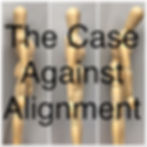Part 1: The Physics of Alignment
- Lanette
- Sep 16, 2019
- 4 min read
Do you think that alignment is important because you’ve thought it through and it makes logical sense to you? Or do you believe in alignment because it has been prioritised by every teacher you’ve ever had since your very first class? It’s been drilled into our heads, into our bodies, into our subconsciouses. We’ve built entire lessons, workshops, courses on it. It is at the heart of so many Pilates practices.
But what if we’re wrong?...

Now hear me out! If you’re an alignment junkie, you’re going to want to dismiss this before you’ve even begun to think about it. That’s normal. Remember what I said about foundational assumptions and that queasy feeling? Well, this is a scary one to think about. If alignment (and posture) aren’t the goal, then what have we been doing?
I realise it will take more than one argument to convince you that alignment is not as simple as it seems to be. So let’s start here:
What is alignment? A series of points that make a straight line. In Pilates (and many other disciplines) “ideal” or “proper” (what a word!) alignment is often considered to be a vertical line of the head (centre of the ear), shoulder, centre of the ribcage, hip (greater trochanter), knee (just in front), and ankle bone (just in front) when viewed from the side. This is also known as “good posture”. Just google “proper alignment” and you’ll see a plethora of hilarious pictures offering advice on what is and is not a “good” way to stand.
But what if my booty is juicy? What if my belly is bulging? What if my shins curve? What if my chest is tight? What if my back is swayed? What if I have osteoporosis? What if I’m wearing a backpack? What if I’m wearing heels? What if I’m carrying a child? A bag of groceries? A chair?
“Proper alignment” does not take into account real world scenarios…like gravity. The people in these diagrams are often thin, uninjured and standing in a way that no one stands for any length of time. (When was the last time you stood: motionless, fully upright, looking straight ahead, empty handed, without leaning on anything?)
It would be super handy if there were a simple formula for judging people physically. But there isn’t. We’re people. There are just too many variables for a formula like “proper alignment” to hold up.
What we should be looking for is balance in relation to the activity at hand.
Standing is a lot more complicated than we care to think about. The act of standing is the very dynamic process of not falling over. We are very tall in relation to the soles of our feet. In physics, that’s not a very stable combination. A shape like that would be very easy to tip. The simple act of taking in a breath would be enough of a redistribution of weight to topple it. (So when was the last time you stood: motionless, fully upright, looking straight ahead, empty handed, without leaning on anything…not breathing?)
There are factors at play in our brains and bodies that work, often unseen, to move our weight around and keep us on our feet. These adjustments are usually very small. But if a larger weight change comes along, a more dramatic adjustment is essential in keeping the balance.
This dramatic adjustment can come in the form of:
a change in the base of support - a wider stance in the feet for example
drawing on another object for assistance - leaning on someone or something
muscular assistance - drawing on the muscles to hold the unnatural shape
redistributing the weight over the feet - changing the shape of the body, often the spine
In order to remain upright, an object’s centre of gravity (centre of mass is more accurate from a physics perspective, but centre of gravity is the accepted term in the human body community) must remain over the base of support (the parts touching the ground and the space between them). If the centre of gravity moves outside of the base of support, the object will succumb to gravity and fall. The easiest (least amount of work, muscularly) stance would be one where the centre of gravity hovers over the centre of the base of support. Again, what we’re looking for is balance. The same amount on one side as the other.
Sometimes “proper alignment” forces the centre of gravity to be a little too close to the edge of the base of support, as it doesn’t take centre of gravity or base of support into account. This will require more muscle work to hold the body upright. Little clenches are needed to keep the body lined up in this unnatural way. It’s probably not the most comfortable way to stand.
I define “ideal alignment” as any stance that requires the least amount of effort to either maintain, or produce the desired task.
That means the look of it will depend greatly on the physics of it. This shift in attitude about optimal positioning allows for a much greater range of people, postures, activities, and loads to be carried. It also allows for a more internal sensation. Rather than relying on the vision of my Pilates teacher, and then trying to remember what “proper” felt like, now I can just look for “easiest” from the internal sensors of my body. And “easiest” can change regularly.
Well, I’m going to let that sink in for a bit. Lots to think about! and LOTS more to come! Be sure to tune in next time for the exciting conclusion!…Well…Part II anyway. 😉



